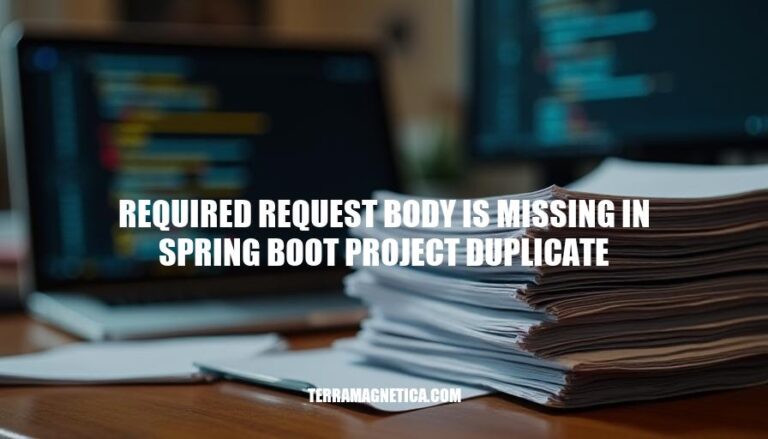


The error “Required request body is missing” in a Spring Boot project typically occurs when a controller method expects a request body but doesn’t receive one. This can happen due to incorrect usage of the @RequestBody annotation, such as not sending the request body in the correct format or missing it entirely. Common implications include failed API calls and disrupted data processing, which can affect the functionality of web applications and services.
In Spring Boot, the “Required request body is missing” error typically occurs due to issues with how the request body is handled or expected by the controller. Here are the technical reasons and how Spring Boot handles request bodies:
Annotation Usage:
Content-Type Mismatch:
Content-Type header (e.g., application/json). If the header is missing or incorrect, Spring Boot won’t be able to parse the request body.Empty Request Body:
Incorrect Method Signature:
@RequestBody on individual fields instead of a single object can cause this error.Message Converters:
HttpMessageConverters to convert the request body into the desired Java object. If the converter fails (e.g., due to incorrect JSON format), the error will be thrown.Validation Annotations:
@Valid or @Validated on the @RequestBody parameter can also cause this error if the validation fails and the request body is deemed invalid.Spring Boot handles request bodies by automatically deserializing the incoming data into Java objects using the configured message converters. The @RequestBody annotation is crucial for this process, and any mismatch or error in the expected format, content type, or method signature can lead to the “Required request body is missing” error.
Here are some typical scenarios where the “required request body is missing” error occurs in a Spring Boot project, along with common mistakes that lead to this error:
Incorrect Annotation Usage:
@RequestBody on individual parameters instead of a single object.public String addUser(@RequestBody String name, @RequestBody String email) {
// Incorrect
}
public String addUser(@RequestBody User user) {
// Correct
}
Missing Content-Type Header:
Content-Type: application/json header.Empty Request Body:
public String updateUser(@RequestBody User user) {
// Expects a non-empty body
}
Incorrect HTTP Method:
GET instead of POST or PUT for endpoints that expect a request body.@PostMapping("/addUser")
public String addUser(@RequestBody User user) {
// Should be POST, not GET
}
Serialization Issues:
Validation Constraints:
public String addUser(@Valid @RequestBody User user) {
// Requires valid data
}
These scenarios and mistakes often lead to the “required request body is missing” error in Spring Boot projects.
Here are the step-by-step troubleshooting methods to resolve the “required request body is missing” error in a Spring Boot project:
Check HTTP Method:
@PostMapping("/endpoint")
public ResponseEntity<?> handleRequest(@RequestBody MyRequestBody body) {
// handle request
}
Verify Content-Type Header:
Content-Type header to application/json or the appropriate type.curl -X POST -H "Content-Type: application/json" -d '{"key":"value"}' http://localhost:8080/endpoint
Check @RequestBody Annotation:
@RequestBody annotation is correctly placed on the method parameter.public ResponseEntity<?> handleRequest(@RequestBody MyRequestBody body) {
// handle request
}
Validate JSON Structure:
public class MyRequestBody {
private String key;
// getters and setters
}
Check for Missing Dependencies:
pom.xml:<dependency>
<groupId>com.fasterxml.jackson.core</groupId>
<artifactId>jackson-databind</artifactId>
</dependency>
Enable HTTP Message Converters:
@Configuration
public class WebConfig implements WebMvcConfigurer {
@Override
public void configureMessageConverters(List<HttpMessageConverter<?>> converters) {
converters.add(new MappingJackson2HttpMessageConverter());
}
}
Check for Filters or Interceptors:
@Component
public class MyFilter implements Filter {
@Override
public void doFilter(ServletRequest request, ServletResponse response, FilterChain chain)
throws IOException, ServletException {
chain.doFilter(request, response);
}
}
Debugging:
@RestController
public class MyController {
@PostMapping("/endpoint")
public ResponseEntity<?> handleRequest(@RequestBody MyRequestBody body) {
System.out.println("Request Body: " + body);
return ResponseEntity.ok().build();
}
}
By following these steps, you should be able to identify and resolve the “required request body is missing” error in your Spring Boot project.
To avoid the “required request body is missing” error in future Spring Boot projects, follow these best practices:
Use @RequestBody Annotation:
@PostMapping("/example")
public ResponseEntity<String> exampleEndpoint(@RequestBody ExampleRequest request) {
// Your logic here
return ResponseEntity.ok("Success");
}
Validate Request Body:
@PostMapping("/example")
public ResponseEntity<String> exampleEndpoint(@Valid @RequestBody ExampleRequest request) {
// Your logic here
return ResponseEntity.ok("Success");
}
Handle Missing Request Body:
@ExceptionHandler(MethodArgumentNotValidException.class)
public ResponseEntity<String> handleValidationExceptions(MethodArgumentNotValidException ex) {
return ResponseEntity.badRequest().body("Request body is missing or invalid");
}
Enable Validation:
Ensure you have the spring-boot-starter-validation dependency in your pom.xml or build.gradle:
<dependency>
<groupId>org.springframework.boot</groupId>
<artifactId>spring-boot-starter-validation</artifactId>
</dependency>
Set Content-Type Header:
Ensure the client sets the Content-Type header to application/json:
HttpHeaders headers = new HttpHeaders();
headers.setContentType(MediaType.APPLICATION_JSON);
HttpEntity<ExampleRequest> entity = new HttpEntity<>(request, headers);
Use Filters for Pre-processing:
Implement filters to modify or validate the request before it reaches the controller:
@Component
@Order(1)
public class RequestFilter implements Filter {
@Override
public void doFilter(ServletRequest request, ServletResponse response, FilterChain chain)
throws IOException, ServletException {
// Modify or validate request
chain.doFilter(request, response);
}
}
By adhering to these practices, you can minimize the chances of encountering the “required request body is missing” error in your Spring Boot projects.
It’s essential to properly handle requests and ensure that the required data is present to avoid this error.
@Valid annotation on the request object to enable validation.Content-Type header to application/json when sending the request.@ExceptionHandler, to handle validation exceptions and return meaningful error messages.By following these best practices, you can minimize the chances of encountering the ‘required request body is missing’ error and ensure that your Spring Boot project handles requests correctly. Properly handling requests is crucial for a smooth user experience and efficient application functionality.